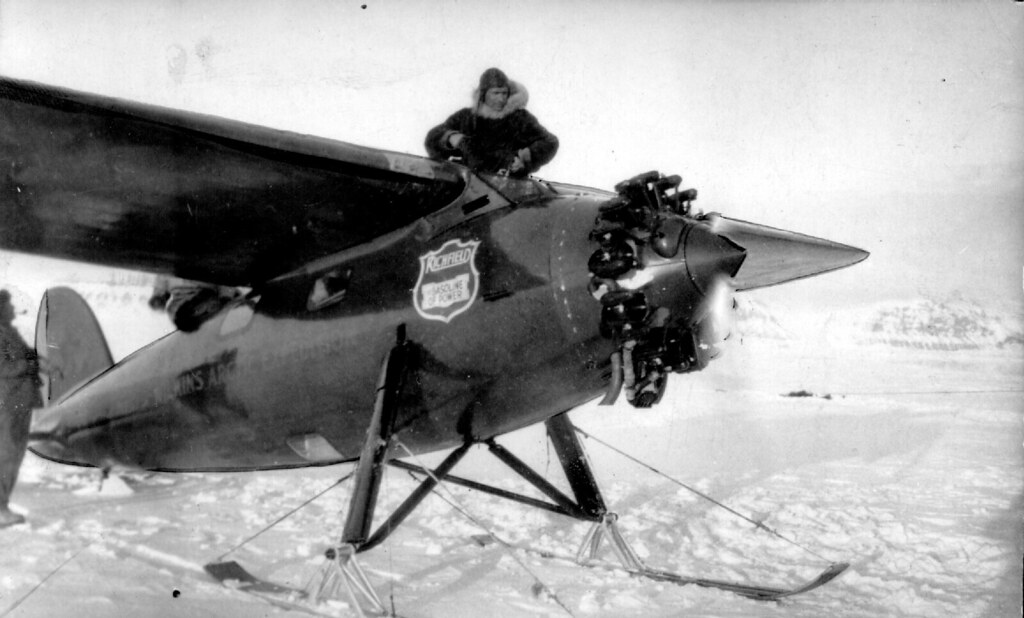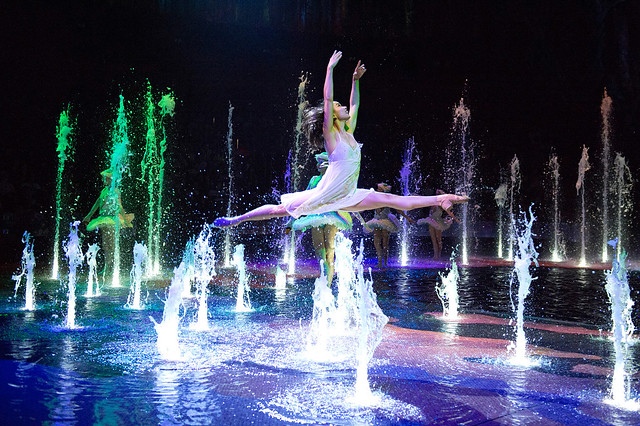
from 'The Aviators' by William Joy (Shakespeare Head Press, 1965)
GEORGE HUBERT WILKINS of Adelaide notched another "first" for Australia when, in 1928, with American Ben Eielson as pilot, he flew over the top of the world from Point Barrow in Alaska to Spitzbergen in the Norwegian isles north of Finland. Born in 1888 at Mount Bryan East, South Australia, and educated in engineering at the Adelaide School of Mines, Wilkins led a life of constant adventure. As far back as 1916, when he ended three years as photographer and second-in-command of Vilhjalmur Stefansson's Canadian Arctic Expedition to join the Australian Flying Corps, he had dreamt of exploring the icy Arctic wilderness in aeroplanes, chancy and unreliable though they then were. With Stefansson, Wilkins learned to live like an Eskimo. He tramped more than 5000 miles with the expedition and became as much at home on ice as an Arctic seal.
From the Flying Corps Wilkins was seconded as official photographer to the Military History Department, in which capacity he was wounded several times taking photographs in battle. Having won the M.C. and bar, he flew with Val Rendle, Reg Williams and Gar Potts in the first England-Australia race in 1919, navigating the Blackburn Kangaroo aircraft which crashed in Crete. In 1920, Wilkins was second-in-command of a not-too successful British Imperial Expedition in which he helped survey part of the Antarctic coastline, then joined Sir Ernest Shackleton's last Antarctic Expedition as naturalist and photographer. Switching back to the sun, he roamed tropical Australia for two adventurous years collecting natural history specimens for the British Museum.
Now (1926) aged 38, he returned again to his earlier dreams of exploring the Arctic from the air and of being the first to fly from America to Europe by the polar route. With his own savings and financial help from Australian friends, Wilkins sailed for America to seek backing there for his polar plans. The City of Detroit voted him a substantial sum. With this and 25,000 dollars from a North American newspaper Alliance for exclusive news coverage of the flight, Wilkins had enough to buy two Fokker aircraft-one tri-motor, the other single-engined. His old Arctic commander, Vilhjalmur Stefansson, put him in contact with Dakota-born 28-year-old Carl Ben Eielson, a crack young "bush pilot", thus forming a partnership that ranks high in Arctic exploration and aviation history.
 |
| Sir Hubert Wilkins (publicity photo) |
In March 1927, Wilkins and Eielson, with two new planes were ready for another aerial attack on the Arctic. Admiral Richard Byrd, the American, had forestalled them to some extent by flying from Spitzbergen to the North Pole and back in 1926, but the whole of the Arctic north of Alaska was still unexplored, and no one as yet had flown from one Continent to another over the North Pole. Most experts declared it just could not be done.
Wilkins decided to start his 1927 programme with a 600-mile flight towards the pole to see if there were any substantial stretches of land or islands still waiting to be found in the vast wastes of ice and snow. They took off from Point Barrow with a blizzard on their tail and were going well 550 miles out when the engine faltered. Rough ice lay beneath them. There was nothing much they could do. They just had to risk a landing. Eielson eased the plane down. The ice held. She skidded along on her skis and came gently to rest in the first landing ever made on Arctic ice.
While Eielson fixed the engine, Wilkins cut a hole in the ice and made a sounding with a listening device and dynamite. He found the ocean mote than three miles deep at that point. They took off and again were forced down. They worked on the engine for some hours in sub-zero temperatures in which four fingers on Eielson's left hand froze. Black clouds blocked the light when at last they were airborne again. Now they were battling, a gale-force headwind without a chance of getting back to base before their fuel ran out. They were not surprised therefore when the engine cut out. Eielson felt his way down to a landing. The wing tip struck an obstruction and spun the plane into a snowdrift.
Neither Wilkins nor Eielson was hurt. For five days they sat out the blizzard in the cabin of their plane, resting snugly in their sleeping bags and living comfortably on their emergency rations of pemmican, biscuits, chocolate, nuts, raisins and malted milk tablets. Then, with a pocket compass and two watches, they set out to walk nearly 100 miles across the ice, back to civilisation. Carrying rifles and with 30 lb. of food bundled with their instruments into sleeping bags, they trudged, stumbled and, in some places, crawled southwards over the ice. Eielson, in constant pain from frostbite, plodded doggedly along with Wilkins. Tragedy was near when the ice gave way under Wilkins while he was skirting a lead of open water. He managed to scramble, soaked to the skin, on to firm ice. Only his knowledge of Arctic lore prevented him from freezing to death. After 13 days of privations, the two men reached a trader's house on Beechey Point, a few miles from Port Barrow. Eielson was taken at once to hospital where surgeons amputated a finger from his frost-bitten hand.
Again Wilkins was forced to postpone his main objective, a flight over the Pole from Alaska to Northern Europe. During the winter he went to San Francisco where, as previously recorded, he met Charles Kingsford Smith and C. T. P. Ulm and sold them the sturdy plane he had built from the Fokkers he smashed up in the Arctic. In San Francisco, Wilkins saw and fell in love with a trim little Lockheed Vega monoplane, whose sleek, bullet-like body offered a minimum of wind resistance and was just the plane for Arctic exploration. The money he got from Smithy and Ulm helped him to buy a Vega. In April 1928, he and pilot Ben Eielson were poised at Point Barrow for the great adventure.
As usual, nothing went smoothly. They had to marshal scores of Eskimos to clear a runway through the snow. Twice, the Vega, greatly overloaded, refused to rise. They had to wait for a head wind before, on April 15, the Vega rose smoothly from the snowy runway and headed for Spitzbergen, 2500 miles away. Weather was mixed. After seven hundred miles they ran into black clouds and were lucky to be able to check their position by glimpses of Greenland mountains. Next they encountered a blizzard which cut visibility to 100 yards. Nearing the end of their journey, they narrowly escaped crashing into the sea. Fuel, now, was dangerously low. Wilkins guided Eielson down to a small strip of ice, confident they had succeeded in their mission and were somewhere in the Spitzbergen group of islands. The 2500-mile flight across the top of the world had taken 20 hours, 20 minutes.
For five days, however, they were stormbound in the cabin of the Vega. Then they took off and, a few minutes later, saw the masts of the wireless station at Green Harbour, where the Norwegian operator and his crew found it difficult to believe they had crossed the Arctic from Alaska.
Honours poured on Hubert Wilkins. King George V knighted him. Scientific bodies and ordinary folk all over the world hailed him as a great explorer and aviator. The newspaper tycoon William Randolph Hearst advanced 25,000 dollars towards the cost of an aerial exploration of the Antarctic. With Ben Eielson as first pilot and another famous airman, Joe Crosson, as second, Wilkins arrived with two Vegas at Deception Island and, in November 1928, made the first flight over Antarctic snows. In December he was off again flying 600 miles out over the high plateau of Graham Land where the foot of man had never trod. On a spot left blank on the map he plotted plateaus, bays, channels and chains of islands none knew existed, returning safely through a fierce storm to base at Deception Island. Not for nothing were Wilkins and Eielson known as "The men who always came back".
 |
| Hubert Wilkins and Suzanne Bennett |
Wilkins now took two years off from flying to embark on another adventurous project, the possibility of exploring beneath the Arctic ice cap in a submarine. For the token price of one dollar, the United States Navy let him- have an out-of-date submarine, about to be scrapped. Lady Wilkins christened it Nautilus. Wilkins fitted the submarine with runners and shock absorbers on top of the hull and with a hollow drill in the conning tower to enable them to cut through the ice for air. In Nautilus, Wilkins hoped to sail from Spitzbergen under the North Pole to Alaska in 42 days.
The Nautilus project was dogged by misfortune. She made one or two trial dives under the ice to prove it could be done before the experiment was abandoned. Wilkins' faith in submarine voyages under ice was vindicated when American nuclear-powered submarines made such trips after World War II.
For the next six years, Sir Hubert Wilkins was manager of the Lincoln Ellsworth Antarctic Expedition. In 1937 he was called back to active flying to search for Russian airman Sigismund Levanevsky, the Soviet Lindbergh, who vanished with five comrades on a flight over the North Pole. Before the search was called off, Wilkins had flown 44,000 miles and searched 170,000 square miles, 150,000 of which had never been surveyed before. Altogether Hubert Wilkins made more than 30 polar expeditions. He died at Framingham, Mass., in 1958. His ashes were taken aboard the American nuclear-submarine Skate which dived under the Arctic floes and surfaced through the ice to scatter them in the vicinity of the North Pole.
Further Reading:
- Sir George Hubert Wilkins page at the Australian War Memorial
- Australian Dictionary of Biography
- Sir Hubert Wilkins Resource Blog















































